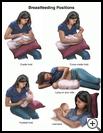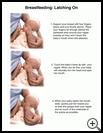
Breastfeeding: Sore Nipples
________________________________________________________________________
KEY POINTS
- Mild nipple soreness is common during the first few days of breastfeeding. Nipple pain that is severe or lasts for a week or more should be checked by your healthcare provider or a lactation consultant.
- If you have an infection, your provider will prescribe medicine to treat the infection.
- Make sure your baby is positioned correctly to nurse. Wash your nipples with mild soap and water and let air dry. After each feeding, put expressed breast milk on your nipples and let them air dry. You can then put a thin coating of USP modified lanolin (medical grade) on your nipples.
________________________________________________________________________
What are sore nipples?
Many women have mild nipple soreness during the first few days of breastfeeding. This usually needs no treatment. However, nipple pain that is severe or lasts for a week or more is not normal and should be checked by your healthcare provider or a lactation consultant.
Nipple pain may cause you to put off nursing or not let your baby suck long enough when he nurses. Sucking helps your milk to flow, so nipple pain may cause a drop in your milk supply. As a result, your baby may not gain weight well.
What is the cause?
The most common cause of severe nipple soreness is the position of your baby's mouth on your breast. The size and shape of your nipples and your baby's mouth can affect how your baby latches on your breast. If your baby is not latching on to your breast correctly, your baby may not be getting enough milk, as well as causing nipple pain.
Other possible causes of nipple pain are:
- Your baby’s sucking habits
- A yeast or bacterial infection of the nipples
- A breast infection
- A spasm of the nipple
- A baby with tongue-tie, which means that the tissue that connects the tongue to the bottom of the mouth is too tight or short. The tongue-tie may cause your baby to press the nipple between his gums.
What are the symptoms?
Symptoms of sore nipples may include pain or tenderness that lasts the whole time that you feed your baby. If you see white patches in your baby's mouth, or your baby has had a diaper rash for 3 or more days, you may have a yeast infection.
Chills, fever, headache, flulike symptoms, lump in the breast, or pain or redness in your breast (not just your nipple) may be a sign of a more serious problem.
How are they diagnosed?
Your healthcare provider will ask about your symptoms and medical history and examine you.
How are they treated?
If you have an infection, your provider will prescribe medicine to treat the infection. Otherwise, the following suggestions should help your nipples feel better within a day or so.
- Make sure your baby is positioned correctly to nurse.
First, support your breast. With one hand, put your fingers under your breast and your thumb on top (C-hold). Your fingers should be on the outside of the areola (the dark area around the nipple) so that they won't touch your baby's mouth when he attaches.
Make sure your baby is facing you. Use the football hold or cross-cradle hold so that you have more control of your baby's head. With your hand, hold the back of your baby's head, his neck, and upper back and shoulders. Your fingers will be behind his ears. Lightly touch your baby's upper lip with your nipple until he opens wide (like a yawn). Quickly move the baby onto your breast, so that his chin and lower jaw touch your breast first. His head should be tilted back slightly as he comes onto the breast. This results in an off-center latch, with his upper lip closer to the top of the nipple, and the lower lip further from the bottom of your nipple. This helps your baby get milk more easily and causes you less pain.
Do not let your baby take only the tip of your nipple. Make sure he gets enough of the lower part of the areola in his mouth. Your baby should get a good, deep latch.
During feeding, support your breast from below so your nipple and areola aren't pulled out of your baby's mouth.
- Begin a feeding on the less sore nipple to trigger your let-down reflex and start milk flowing.
Babies suck harder at the start of feedings. After your baby has nursed briefly and milk flow has begun, move him to the breast with the sore nipple. This should make nursing more comfortable because your baby won’t suck as hard once milk starts to flow.
- Carefully dry your nipples and use lanolin.
Wearing wide-based breast shells over your nipples between feedings can reduce discomfort and speed up healing by preventing direct contact with your bra. You can also wear hydrogel pads to provide soothing, cooling relief.
If you wear breast pads, change them as soon as they get wet. Gently pat your nipples dry with a clean cloth after nursing. Wash your nipples with mild soap and water when you bathe. Air dry your breasts. After each feeding, put expressed breast milk on your nipples and let them air dry. You can then put a thin coating of USP modified lanolin (medical grade) on your nipples. This will keep your skin from getting too dry.
- Use a pump to express your milk if the pain is so severe that you cannot nurse your baby.
- You can stop nursing and pump milk for 1 to 3 days while your nipples heal. You can rent a hospital-grade electric pump for a short time. Pumping is a good way to drain your breasts and maintain or increase your milk supply while your nipples heal. To find where you can rent a pump, contact your healthcare provider or lactation consultant.
Last modified: 2017-12-11
Last reviewed: 2017-12-11


